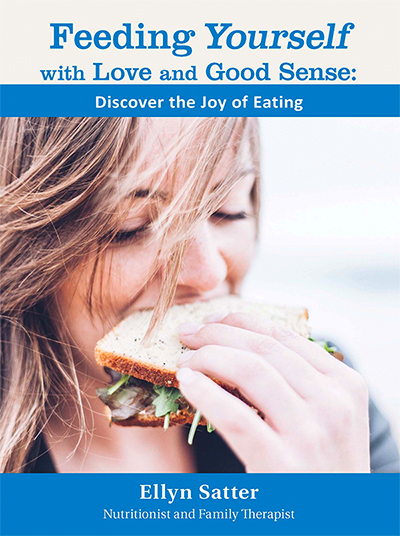Courses
Courses
At ESI, we believe in the power of education to ignite change, inspire confidence, and unlock untapped potential. Our courses are designed to equip you with the knowledge, skills, and mindset needed to use the Satter models to their full potential.
Child Feeding: Which Course Level is Right for Me?

FEEDING CHILDREN: AN INTRODUCTION TO THE TRUST APPROACH
LEVEL
Introductory
INTENDED AUDIENCE
Professionals who provide basic child feeding support to parents/caregivers. Appropriate for child care providers and health care professionals.

FEEDING CHILDREN: SUCCESS IS IN THE DETAILS
LEVEL
Intermediate
INTENDED AUDIENCE
Practitioners who provide child feeding education and advice to parents/caregivers at a primary intervention level. Could be appropriate for individuals new to the Satter models.

FEEDING WITH LOVE AND GOOD SENSE
LEVEL
Mastery
INTENDED AUDIENCE
Practitioners who provide child feeding education and advice to parents/caregivers at a primary and/or secondary intervention level. Not intended for those new to the Satter models.
Introductory: Child Feeding Course
An Introduction to the Trust Approach
 If you are new to ESI, this online course will introduce you to the Satter Division of Responsibility in Feeding (sDOR), or the “trust approach.” This approach clearly outlines the different roles both caregivers and children have at eating times, and represents a shift in thinking by focusing on supportive feeding practices that aim to build trust between the parent and child. This course is designed to help equip a variety of professionals to have informed conversations with caregivers about feeding children and implementing sDOR to support positive eating behavior. Upon completion of the course participants will be able to explain sDOR, help caregivers implement best practices in feeding children, help children grow up to be competent eaters, and help guide caregivers in managing common feeding issues.
If you are new to ESI, this online course will introduce you to the Satter Division of Responsibility in Feeding (sDOR), or the “trust approach.” This approach clearly outlines the different roles both caregivers and children have at eating times, and represents a shift in thinking by focusing on supportive feeding practices that aim to build trust between the parent and child. This course is designed to help equip a variety of professionals to have informed conversations with caregivers about feeding children and implementing sDOR to support positive eating behavior. Upon completion of the course participants will be able to explain sDOR, help caregivers implement best practices in feeding children, help children grow up to be competent eaters, and help guide caregivers in managing common feeding issues.
What You'll Learn
- How to help caregivers follow the Satter Division of Responsibility in Feeding
- How to help children grow up to be competent eaters
- How to guide caregivers in managing common feeding issues
Who would benefit from this program?
Anyone wanting to learn the basics of the Satter Division of Responsibility in Feeding (sDOR) will benefit from this short course that delivers all the essentials needed to understand and implement Satter’s trust approach in a way that is clear and concise. Developed as a brief and solid introduction to sDOR, this course is recommended as part of the on-boarding training for WIC (Special Supplemental Nutrition Program for Women, Infants, and Children), Head Start (Early Childhood), and clinicians, healthcare providers, nutrition professionals, childcare staff, or educators who spend time working directly with families in nutrition appointments and health care visits.
Course Details
The course is divided into seven short segments or modules focusing on specific topics. Each module takes approximately 10-15 minutes to complete and includes a brief presentation of basic information related to sDOR, reflection activities and quiz questions. In addition, there are handouts and research and theory articles that you can download and refer to as needed. The course is delivered on a virtual online platform and takes approximately two hours to complete. After purchase, you’ll have access to the course content for three years.
Cost: $59
Course Discounts: For group, student, and equity discount information, email us at [email protected].
Approved for 2 Level II CEU’s by the Commission on Dietetic Registration
Intermediate: Child Feeding Course
Feeding Children: Success Is In The Details
The Satter Division of Responsibility in Feeding (sDOR) is the gold-standard approach to feeding children. This is a self-paced intermediate-level online course, and will teach you how to help your clients apply the division of responsibility to prevent, as well as solve common feeding problems including picky eating, exploring new foods, and planning shared meals.
Expert ESI Faculty members will walk you through how to set parents, caregivers and early childhood educators on a path to success with new strategies to address worries about how much a child eats, weight concerns, and other common feeding challenges. Take a deeper dive into handling the nuances of providing mealtime structure along with strategies for offering a variety of enjoyable foods (including those higher in calories, fat and sugar) in considerate and caring ways that support the health and nutrition of the child. Discover practical ways to integrate this approach into your work.
This course has been approved for 16 CEUs from the Commission on Dietetic Registration.
What You'll Learn
As part of your learning journey you will listen to lectures, work on case studies and activities using a guided workbook and complete quizzes related to different areas of application, including:
- The five principles to help parents take leadership with feeding. This includes strategies for offering new and unfamiliar foods, foods that may take longer to accept, and how all foods can be enjoyed regardless of nutrition composition.
- Assessing parents’ adherence to the Satter Division of Responsibility in Feeding using a measure called the “sDOR 2-6 year inventory” and learn how to get permission to use this resource in your practice.
- How to address feeding challenges such as picky eating and weight divergence, along with practical tips for managing desserts and sweetened beverages at meals and snacks.
- Important steps in helping families develop success serving shared meals.
- Key ways to create trust-based, experiential client learning materials and programs.
Who would benefit from this program?
Anyone wanting to go beyond the basics of the Satter Division of Responsibility in Feeding. This course delivers a wealth of practical information for health professionals in primary care and some secondary settings with brief or limited assessment and follow up visits. Examples of these include:
- WIC (Special Supplemental Nutrition Program for Women, Infants, and Children) and Head Start (Early Childhood) clinicians and educators who spend time working directly with families in nutrition appointments and health care visits, assessments, etc.
- Dietitians, nurses, physicians, speech language pathologists and other clinicians in outpatient primary or short-term secondary care settings (brief or limited assessment and follow-up visits where you might work with a family for one to three visits)
Course Details
Feeding Children: Success is in the Details will explore the intricacies involved in the application of the Satter Division of Responsibility in Feeding (sDOR). The course includes ten modules and three case studies (picky eating, child weight divergence, and Satter-consistent nutrition education), along with activities, supplemental research articles, and quizzes.
This course includes a curated mix of informative, engaging, and interactive expert content including:
- 16+ hours of instruction including self-directed learning and application
- Newly recorded presentations and video simulations by ESI faculty members
- Digital workbook
- Handouts to use with your clients
- Virtual group discussion chats to review concepts and case studies with other participants and monitored by ESI faculty
- Digital copies of two popular Feeding with Love and Good Sense booklets
- One-time discount for Ellyn Satter Institute store
- Three years of access to the course
This self-study is housed on our online learning Teachable platform. If you are new to Teachable, you will need to create a free account. Please direct any questions and inquiries to [email protected].
Cost
$399.00
Course Discounts: For group, student and equity discounts email us at [email protected].
CEUs
After you successfully pass the final exam with a score of 70% or higher, and complete and submit a course evaluation, you will receive a completion certificate for submission to the Commission on Dietetic Registration (CDR).
Commission on Dietetic Registration Performance Indicators:
10.3.9 Leads the implementation of nutrition interventions in collaboration with clients/patients and the inter-professional team.
4.2.6 Integrates relevant information with previous learning, experience, professional knowledge, and current practice models.
9.3.5 Uses a variety of strategies to deliver education.
9.4.2 Assesses and identifies the current knowledge, skills, and cultural influences of populations.
Master Course: Child Feeding
Feeding with Love and Good Sense
Next Session
Spring 2026
Next Session
September 24, 2025
Next Session
September 24, 2025
The Satter Division of Responsibility in Feeding (sDOR) is the gold-standard approach to feeding children. ESI’s Childhood Feeding Master Course: Feeding with Love and Good Sense teaches you everything you need to know to offer child feeding assessments and secondary intervention for established feeding problems in your clinical office. The workshop addresses feeding concerns from birth through early school-age including picky eating, weight acceleration, growth faltering, and special needs.
Objectives
Upon successful completion of this course, you will be able to:
- Cite literature addressing the theoretical underpinnings and evidence for the Satter Feeding Dynamics and Eating Competence models.
- Learn how to apply the principles of child development to the assessment and treatment of child nutrition problems.
- Understand and interpret a child’s growth pattern to support optimum feeding at different developmental stages and treat feeding problems.
- Differentiate between primary, secondary, and tertiary intervention in addressing child feeding problems.
- Identify distinctions between education and psychotherapy.
What You'll Learn
An estimated 50% of children have established feeding problems.1 Current norms around feeding and eating are such that children are often raised to have poor eating attitudes and behaviors. Many parents have trouble taking appropriate leadership with feeding, while at the same time, they interfere with the child’s autonomy with eating. This interference or neglect with feeding precipitates feeding problems that, at each stage of development, become more complicated, established, and resistant to resolution. Thorough assessment and skillful, step-by-step application of the Satter Division of Responsibility in Feeding has profound implications for the child’s nutrition and growth and also for the quality of life and emotional well-being of the child, parent, and family.Who will benefit from attending?
Experienced health or mental health professionals who work with established and entrenched childhood feeding problems.
Health professionals looking for advanced training in clinical intervention to address feeding and eating concerns.
1 ;Benjasuwantep B, Chaithirayanon S, Eiamudomkan M. Feeding problems in healthy young children: prevalence, related factors and feeding practices. Pediatr Rep. 2013 Jun 13;5(2):38-42. doi: 10.4081/pr.2013.e10. PMID: 23904965; PMCID: PMC3718228.
Course Details
- 9 weeks: Sept. 24, 2025 – November 19, 2025
- Virtual online platform
- Learning modes: Lecture, case study, video, problem-solving, role-playing, group discussion
- Weekly live discussion/Q&A sessions (Wednesdays 6 pm – 7 pm CT)
- Contact hours: 40 hours of continuing education
- Certificate of completion
- 20% discount on ESI materials (some restrictions apply)
- Cancellation: ESI reserves the right to cancel up to 2 weeks prior to the start of the course. Full registration will be refunded to same payment method.
Registration:
$1,175 for individual registration
$1,075 (each) for 2 or more participants
$975 (each) for 4 or more participants from the same organization or agency
Master Course: Treating the Dieting Casualty
Assessing and treating established adult eating problems
At the heart of a good relationship with food is the principle of Eating Competence which is a practical, reliable, joyful, food-neutral and weight-inclusive approach to eating that supports physical, nutritional, and emotional well-being. Individuals who are “dieting casualties” experience the opposite of Eating Competence when they feel trapped in the anguish and frustration of struggling with their eating and/or weight. This master course is an in-depth program that trains the health/mental health professional, to help individuals become competent eaters. Learn the How to Eat method of assessment and treatment refined by Ellyn Satter in over 35 years of clinical practice and successfully applied by hundreds of professionals who have taken this course. While How to Eat carefully avoids doing psychotherapy, successful application profoundly impacts quality of life and emotional and physical health and well-being.
Objectives
Upon successful completion of this course, you will be able to:
- Understand and implement the How to Eat method by doing secondary intervention (detailed assessment and treatment) to address eating attitudes and behaviors, weight preoccupation, and physical activity.
- Cite literature addressing the theoretical underpinnings and evidence for the Satter Model and a weight-neutral approach to health.
- State the theoretical basis of treatment.
- Consider the childhood antecedents that interrupt Eating Competence in assessment and treatment.
- Differentiate among providing education and doing treatment in addressing eating problems, and learn how to stay within your scope of practice.
- Understand and apply treatment based on tested cognitive and behavioral modification protocols with clearly defined step-by-step strategies for clients to practice to help improve awareness and reconnect with internal body signals to regulate and manage eating.
- Learn how to address emotional eating patterns.
What You'll Learn
Learn how to help patients struggling with their weight.
Individuals who are considered “dieting casualties” simply do not know how to eat. They represent the extreme of today’s all-too-common struggle with what and how much to eat. They feel undeserving of experiencing pleasure in food and eating and experience eating as unrelenting misery, conflict, and shame. They often tell themselves, “don’t eat so much; don’t eat the foods you like,” and may have repeatedly lost and regained weight. These individuals are also disconnected from their wants and needs related to eating and do not trust their body to regulate. This results in them only responding to extreme feelings of hunger, food cravings, and fullness. The dieting casualty might restrict food and then overeat or binge, be very rigid in their food selection, fail at following a therapeutic diet, or be obsessed with eating foods they consider to be “healthy.”
- Clients who successfully complete the How to Eat intervention build skills in Eating Competence which means they become more tuned-in, organized, relaxed, and positive about eating.
- The How to Eat intervention empowers clients to determine what and how much to eat based on internal regulators which allows body weight to stabilize, and they can begin to accept weight-neutral approaches.
- The How to Eat intervention can also be used for doing medical nutrition therapy with patients suffering from medical conditions including diabetes, cardiovascular disease, gastrointestinal issues, weight acceleration and/or instability.
- The How to Eat intervention is not appropriate for those with anorexia nervosa who are in the beginning renourishment and weight restoration phase of treatment. However, How to Eat may be used to establish or improve Eating Competence for those in the recovery phase from an eating disorder.
Course Details
- 8 weeks
- Virtual online platform
- Learning modes: Lecture, case study, video, problem-solving, role-playing, discussion
- Weekly live discussion/Q&A sessions
- Contact hours: 40 hours of continuing education
- Certificate of completion
- 20% discount on ESI materials (some restrictions apply)
- Cancellation: ESI reserves the right to cancel up to 2 weeks prior to the start of the course. Full registration will be refunded by same method of payment.
Registration:
$1,175 for individual registration
$1,075 (each) for 2 or more participants
$975 (each) for 4 or more participants from the same organization or agency
Next Session
February 4, 2026

